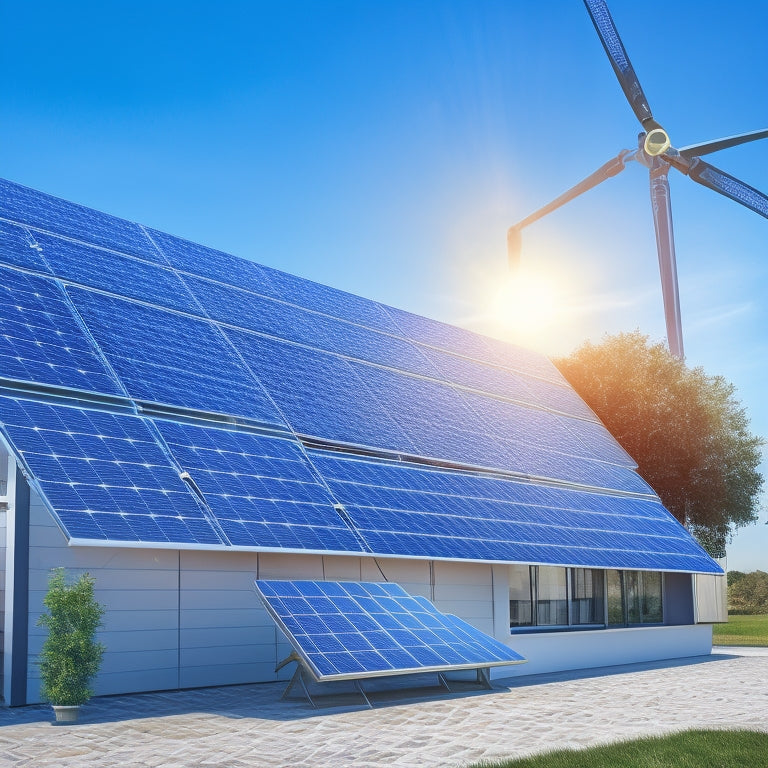
5 Best Ways to Calculate Commercial Solar Costs
Share
You'll need to take into account several key factors to accurately calculate the costs of your commercial solar project. First, assess your system's size and complexity by evaluating your building's energy consumption and available space for the solar panel array. Next, evaluate local incentives and rebates, such as federal and state tax credits, utility partnerships, and net metering. Then, calculate energy savings and ROI, considering your current energy usage and projected future needs. Additionally, factor in installation and maintenance costs, as well as online solar cost calculators for rough estimates. Now, discover the nuances of each factor to get an accurate calculation.
Key Takeaways
• Evaluate energy consumption and available space to determine the required system size and optimize panel layout for peak efficiency.
• Consider federal, state, and local incentives, such as tax credits, utility partnerships, and rebates, to reduce system costs.
• Calculate energy savings and ROI by analyzing current energy usage, estimating future needs, and considering system size and local rates.
• Factor in installation and maintenance costs, including labor, warranty options, and inverter replacement, to determine financial viability.
• Utilize online solar cost calculators to get a rough estimate of expenses based on system size and location, and plan budget accordingly.
Assessing System Size and Complexity
Determining the most suitable system size and complexity for your commercial solar installation involves evaluating several factors, including your energy usage patterns and available roof or land space.
You'll need to evaluate your building's energy consumption to determine how much power you need to generate.
Next, consider the available space for your solar panel array, taking into account any obstructions or shading issues.
A well-designed system should balance energy production with cost and space constraints.
Your system design should optimize panel layout to maximize energy output while minimizing installation costs.
A thoughtful panel layout will guarantee that your system operates at peak efficiency, providing a strong return on your investment.
Evaluating Local Incentives and Rebates
As you navigate the process of calculating commercial solar costs, you'll want to tap into local incentives and rebates that can greatly offset your upfront investment. These incentives can vary by state and even utility company, so it's essential to research and understand the specific programs available to you.
| Incentive Type | Description |
|---|---|
| Federal Tax Credit | 26% of total system cost |
| State Tax Credit | Varies by state, e.g., 10% in California |
| Utility Partnerships | Discounts on electricity rates or rebates from utilities |
| Net Metering | Credits for excess energy produced |
| Local Government Rebates | Cash incentives from local governments |
Calculating Energy Savings and ROI
You'll need to calculate the energy savings and ROI of your commercial solar panel system to understand its financial viability and make informed decisions about your investment.
To do this, you'll need to determine how much energy your system will produce and how much you'll save on your energy bills. This will involve analyzing your current energy usage and projecting your future energy needs.
You can then use this data to estimate your energy savings and calculate your ROI. Consider factors like energy efficiency, system size, and local electricity rates to create accurate financial projections.
Considering Installation and Maintenance
Your commercial solar panel system's installation and maintenance costs can greatly impact its overall financial viability, so it's important to factor them into your calculations from the outset. These costs can vary widely depending on factors such as system size, complexity, and location.
| Cost Category | Average Cost | Description |
|---|---|---|
| Labor Costs | $0.25 - $0.50 per watt | Installation, testing, and commissioning of the solar panel system |
| Warranty Options | $0.05 - $0.10 per watt | Extended warranty options for parts and labor |
| Maintenance Costs | $0.01 - $0.05 per watt | Regular cleaning, inspection, and repair of the solar panel system |
| Inverter Replacement | $0.05 - $0.10 per watt | Replacement of inverters every 10-15 years |
Using Online Solar Cost Calculators
To get a quick estimate of your commercial solar panel system's costs, you can utilize online solar cost calculators that provide a rough breakdown of expenses based on system size, location, and other key factors.
These calculators can give you a rough idea of panel pricing and help you plan your budget. Keep in mind that calculator accuracy depends on the complexity of the calculator and the data you input.
Be prepared to provide specifics about your project, such as system size, installation type, and local incentives.
Frequently Asked Questions
What Is the Typical Lifespan of a Commercial Solar Panel System?
"Your commercial solar panel system is like a fine wine, getting better with age. Expect a typical lifespan of 25-30 years, thanks to system longevity and panel durability, ensuring a strong ROI for your investment."
Can I Install a Solar Panel System on a Leased Building?
Before installing a solar panel system on a leased building, you'll need to obtain landlord permission, review your lease agreement, confirm rooftop access, and comply with building restrictions, while respecting property rights.
How Often Should Commercial Solar Panels Be Cleaned?
You'll be surprised to know that dirty solar panels can lose up to 25% of their energy output. To maintain peak Panel Efficiency, clean your commercial solar panels every 6-12 months, as Dirt Accumulation reduces energy production over time.
Do Commercial Solar Panels Require Special Insurance Coverage?
You'll want to explore specialized insurance coverage for your commercial solar panels, as standard policies may not cover unique risks; expect to pay higher insurance premiums for thorough policy coverage that safeguards your investment.
Can I Sell Excess Energy Back to the Grid?
You can sell excess energy back to the grid through Net Metering, where your utility company credits you for surplus energy; or explore Energy Trading, where you directly trade excess energy with other consumers or producers.
Related Posts
-

Top-Rated Solar Storage Solutions for Homeowners
When considering top-rated solar storage solutions, you're looking at systems that provide energy independence and si...
-

High-Performance Energy-Efficient HVAC Systems
High-performance energy-efficient HVAC systems are essential for reducing energy consumption while improving indoor c...
-

Eco-Friendly Energy Storage Systems for Houses
Eco-friendly energy storage systems for your house let you capture and use renewable energy efficiently. You can choo...


